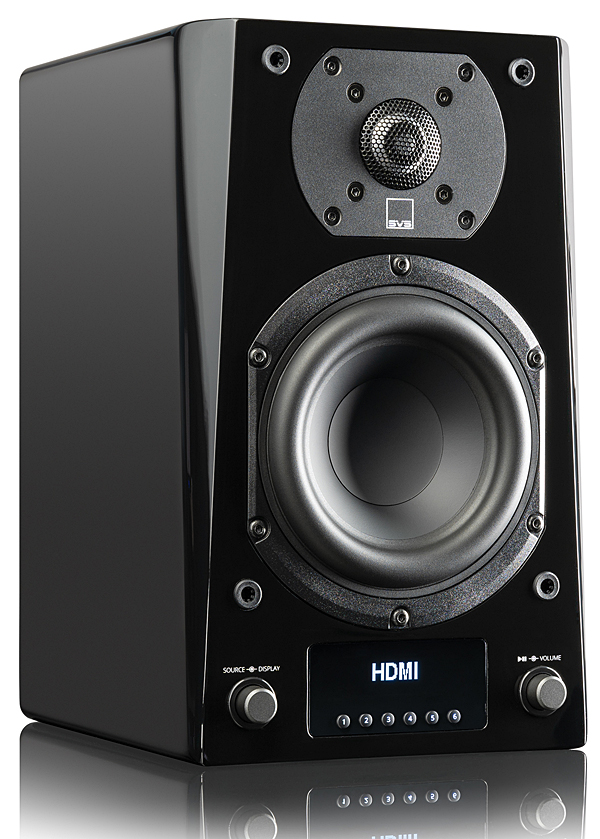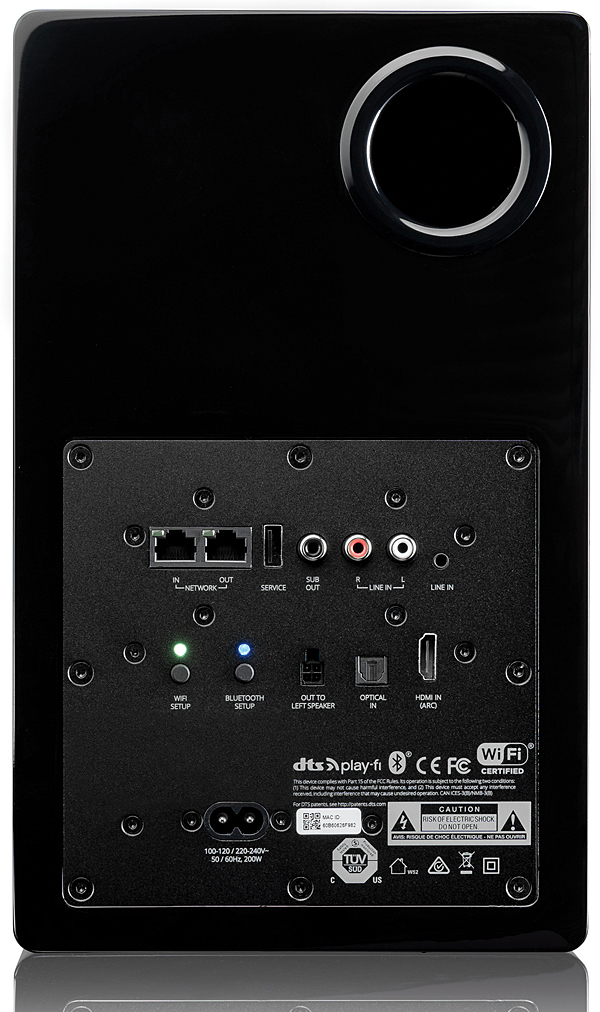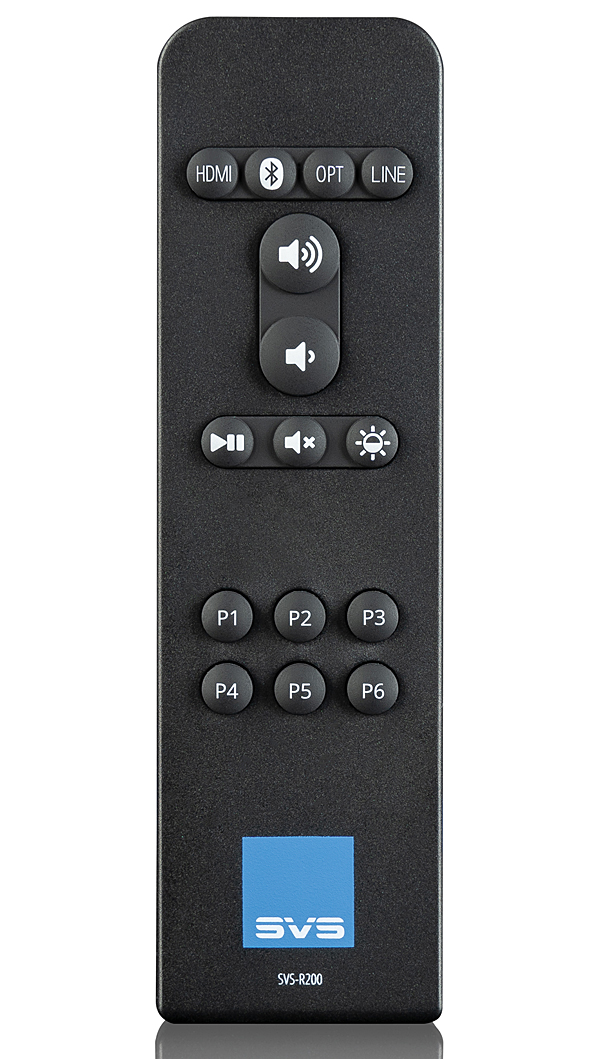| Columns Retired Columns & Blogs |
It looks like I have another speaker to recommend to friends who are 'just music-lovers'... Thanks!

Inevitably, clown cars don't do as much for me as they used to. But I still marvel at the promise of outsized entertainment that will fit in an impossibly small container. Take the brand-new SVS Prime Wireless Pro speakers. Each 7" wide and barely a foot tall, they're just a smidge more imposing than their predecessor, the four-year-old SVS Prime, which had a 4.5" woofer (vs the 5.25" specimen in the current model). A 1" aluminum-dome tweeter, input selector knob, volume knob, and a larger digital display round out the front of the right (main) speaker. Its left sibling has no controls of any kind, nor any binding posts—only a small square receptacle the size of a TosLink bus where you plug in the four-pin umbilical from the primary.
In addition to cabinet bracing and active DSP-controlled crossovers, the duo's innards consist of everything needed for a ton of serious high-end fun. Preceded by a built-in preamp, four 50-watt class-D amplifiers power the drivers. Two 24/192 DACs do the hi-rez honors, and an internal streamer lets you play your favorite tracks from your phone or tablet via Spotify Connect, Chromecast, Apple AirPlay 2 and Bluetooth 5 with AptX.

There are five physical inputs on the rear panel, a hand's breadth below the off-center port: RCA, TosLink, 1/8" aux, HDMI ARC and eARC, and Ethernet. There's a single subwoofer output but no USB audio input. Why? SVS President and CEO Gary Yacoubian explained: Because "there are a few flavors of input connection we decided to leave out. The additions of AirPlay and Chromecast have unlocked almost every device and way of connectivity we would need, including those that might have previously used USB."
I have a soft spot for the SVS speakers' all-in-one approach, and by extension, for similar concepts like KEF's LS50 Wireless speakers—I owned both generations—and the terrific Vanatoo Transparent One Encores ($599.99/pair),1 which I re-auditioned for this review. At $899/pair, the Prime Pros stake out middle ground between the $2799/pair KEFs (footnote 1) and the Vanatoos.
One reason I like a good, all-in-one stereo system is that it fore-stalls certain forms of audiophilia nervosa. There are no speaker cables to obsess over and no nagging thoughts about whether a different amp might boost performance. Plus, at this price level, mercifully, a multikilobuck power-cord upgrade makes no sense. Speakers like this pretty much force you to take them as they are. I cheer them on: "Convenience" isn't a dirty word in hi-fi, or at least it shouldn't be.
I loved the KEFs (bright as they sometimes sounded), and I think the Vanatoos are jawdroppingly good, even without adding "for the price." Let's see how the SVS Prime Pros stack up.
SVS Pros ... and cons
There's no point keeping you in suspense: I had a most excellent time with the little SVS speakers—so much so that I'm going to sing their full-throated praise a little farther down. But first, let me get out of the way what I found less than A-OK about them. (Happily, none of it is a dealbreaker.)

It's not ideal that SVS provides no option to use the main speaker on either side. If you value a correct stereo image, the primary has to be placed on the right. The KEFs and Vanatoos let you designate the main speaker for either channel, the KEFs via a dedicated smartphone app, the Vanatoos with a hardware switch. Why does it matter? Because setup depends on the proximity of AC receptacles and on where you want to place a subwoofer if you use one. When I auditioned the Prime Pros in my home office for a short spell, it would have been much more convenient if I could have put the main speaker on the left. There, access was easy.
A related niggle: If you place the Prime Pros on your desk, the volume knob—the physical control that's used the most—is the farthest away from you of all eight front protuberances (the others being an input selector that doubles as a way to dim or turn off the display and six direct-access buttons that function as customizable presets).
If I could have positioned the main speaker on the left, the volume knob would have been the one closest to me: less leaning and reaching. I concede that this is a first-world problem, but that's where I—and presumably most SVS customers—live.
Some competing powered speakers have physical or software controls that let the user "tune" the speakers according to their distance from the rear wall and/or the corners of a room. The Prime Pros don't offer this. When I asked why, Yacoubian explained that such a feature "sometimes does more harm than good to the signal processing of the product and can leave customers questioning the performance." His engineering team, he says, "understands how to voice a great speaker without adding tone controls." I believed it when I heard the Prime Pros.
Finally, the Prime Pros contain a Caprica 5 Play-Fi chip, which the company calls "state of the art." That means that the Prime Pros are intended to be used with the DTS Play-Fi app (footnote 2). I personally don't know anyone who loves Play-Fi, and I count myself among the skeptics. The app gave me endless trouble when I used it to control a MartinLogan Crescendo X speaker a few years ago, crashing like a Ford Fiesta (footnote 3), and it would often drop the connection to the device at intervals measured in minutes.
I'm all for second chances, so I downloaded the software, which has since been extensively revised (footnote 4), and tried again. The verdict: Better, but no bliss. Play-Fi finally added gapless playback, but the software hasn't yet mastered the art of hurrying up: When I hit the play button, sometimes five or six seconds ticked by before the music started. A few tracks inexplicably stopped after half a minute or so.

In the end, luckily, you don't need Play-Fi, except for the occasional firmware update, or to integrate the Prime Pro speakers into a multiroom system with products from other audio brands, if that's your bag. Play-Fi is brand-agnostic. As Yacoubian rightly notes, you'll be 100% fine if you use other control methods. During my time with these speakers, I mostly streamed music through Tidal Connect, Roon, and my Naim Uniti Atom. The SVS Prime Pro system is nothing if not versatile.
Pleased to meet you
I first encountered the SVS Prime Pros almost half a year before their mid-October launch, at the 2022 AXPONA audio show in Chicago. Halfway through the demo, the SVS team revealed that the visually prominent subwoofer in the room was, in fact, unplugged. None of the guests had caught on, apparently, and a few of us had noted good bass weight—proof of how deep and convincing the Prime Pros can play all by themselves.
Footnote 2: See play-fi.com.
Footnote 3: According to the Insurance Institute for Highway Safety, the Ford Fiesta is the most-crashed car in America.
Footnote 4: In its presentation to the EISA hi-fi committee, at least one editor/panelist questioned the use of Play-Fi on similar grounds. The SVS folks defended it, saying that it had improved and encouraging the panelists to keep an open mind. The Prime Pros won the award for Best Value Wireless Loudspeaker.—Jim Austin

It looks like I have another speaker to recommend to friends who are 'just music-lovers'... Thanks!

How long is the required interconnecting cable , that is , how widely may they be separated ?

In stand mount application, with tweeter at ear height for seated listener, approximately 1 meter above the floor, with the cable running along the floor, that uses nearly 2 meters of cable just to reach the floor from both loudspeakers, leaving a little over 1 meter for separation distance between the pair, which seems to be grossly inadequate for most applications other than using these as powered multimedia desktop computer speakers. The review should have highlighted the short length of that cable.
The cable assembly is terminated with cable end connectors which seem unusual in this application, maybe Molex connectors. If you want to assemble a longer cable for your application, you will need to investigate / reverse engineer that unusual OEM cable assembly, acquire the connectors, contacts, suitable crimping tool, etc.
I would have liked to have seen use of 4-pole Speakon connectors, commonly used in professional audio applications and easily assembled.

SVS provides alternative cable lengths of 15' and 20'... so no reverse engineering required. All you have to do is email them when you order... I opted for the 15' cable that I needed separation for in a large bookshelf, and they didn't charge me any extra. There you go...